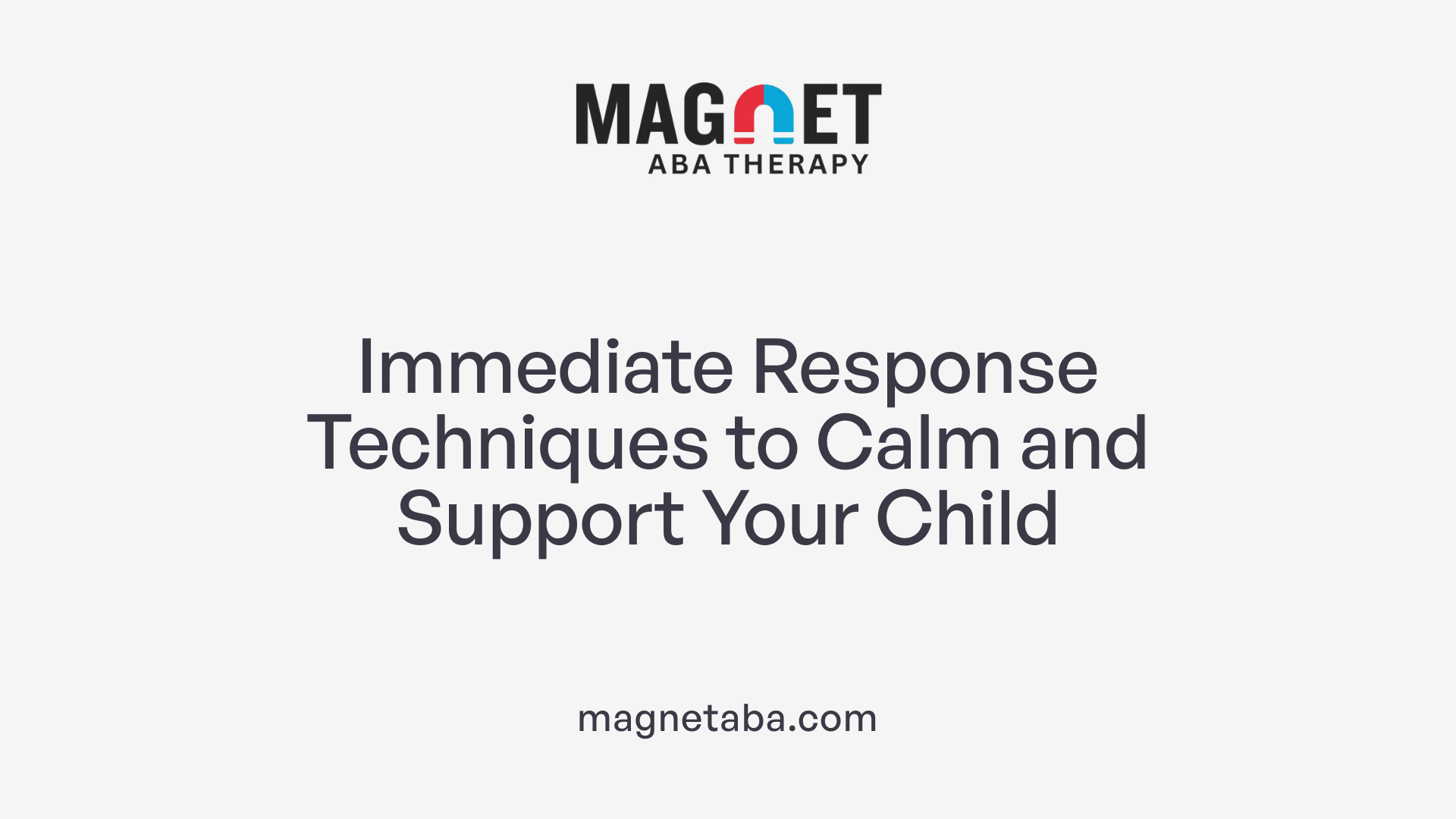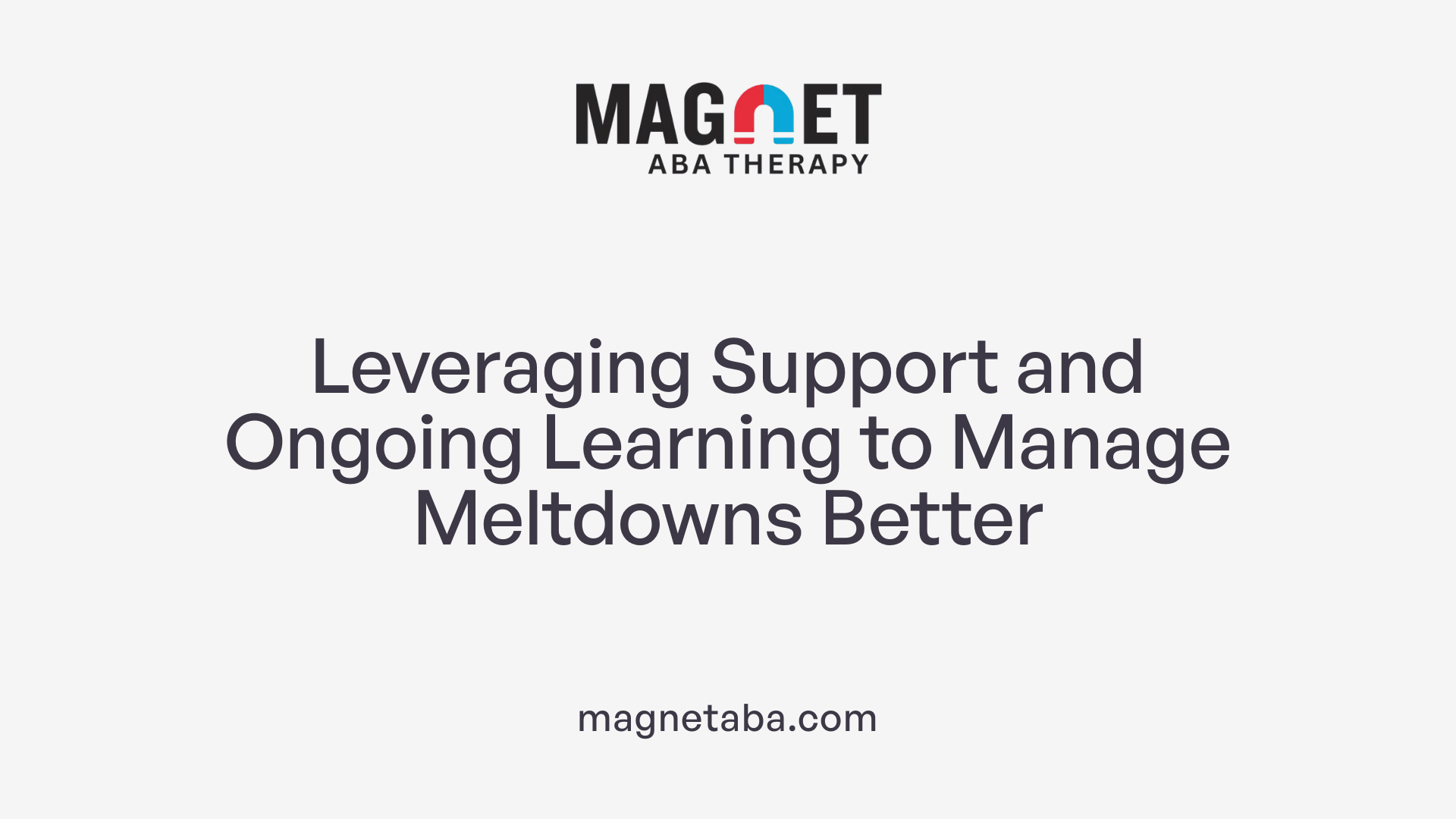Understanding and Addressing Public Meltdowns in Children with Autism
Public meltdowns in children with autism can be overwhelming for caregivers and bystanders alike. Recognizing the nature of meltdowns, identifying triggers, and employing tailored strategies rooted in Applied Behavior Analysis (ABA) can significantly improve outcomes. This article explores comprehensive tips and techniques to effectively handle public meltdowns, emphasizing preparation, calmness, and professional support.
Preparation and Prevention are Key

How can caregivers effectively handle public meltdowns in children with autism?
Handling public meltdowns in children with autism can be challenging, but with the right approach, caregivers can manage these situations effectively. The first step is to remain calm, acting as a steady emotional anchor to help the child feel safe. Children with autism often pick up on adult emotions, so maintaining composure encourages them to calm down.
Providing empathy and validation of the child's feelings is essential. Physical comfort and reassurance can help the child sense security and start to regulate their emotions. Advanced preparation is also crucial. Bringing familiar soothing items, such as comfort objects or noise-canceling headphones, can reduce overstimulation.
Clear communication before outings—using visual schedules or social stories—sets expectations and lessens anxiety. Recognizing common triggers, like loud noises, bright lights, or hunger, allows caregivers to plan accordingly.
During a meltdown, creating a safe space where the child can retreat, such as a quiet corner, is helpful. Employing calming strategies like simple language, deep breathing exercises, or sensory tools can facilitate self-regulation. Consistency, patience, and understanding are vital in building trust and aiding the child's emotional development.
The overarching goal is to support the child's needs while fostering a sense of security, which can help prevent future meltdowns and improve overall well-being.
What are some practical strategies for managing public meltdowns in children with autism?
Proactive strategies include using visual supports and social stories, which prepare children for upcoming activities and reduce unexpected surprises. Establishing predictable routines and clear, simple expectations help children know what to anticipate, decreasing anxiety.
During outings, having designated calming items—such as favorite toys or sensory objects—helps the child self-soothe. When a meltdown begins, caregivers should stay calm and employ grounding techniques like gentle eye contact, tactile pressure, or visual imagery to promote regulation.
Providing opportunities for breaks and allowing the child to step away from overwhelming stimuli can prevent escalation. If a meltdown occurs, ensuring the child has access to a quiet space fosters safety.
Post-meltdown, offering comfort, reassurance, and teaching coping strategies reinforce learning and resilience. The use of positive reinforcement, such as praise or small rewards for calm behavior, motivates children to develop self-regulation skills.
Seeking support from professionals experienced in Applied Behavior Analysis (ABA) can tailor intervention strategies for each child, addressing specific triggers and behaviors.
Caregivers' self-care is also critical; staying calm models appropriate behavior and helps create a supportive environment.
How do prevention techniques like social stories, visual cues, and coping mechanisms reduce the likelihood of meltdowns?
Prevention techniques focus on reducing anxiety and providing clear guidance to children with autism. Social stories and visual cues are effective tools that explain what to expect during activities and outings, helping children understand routines and reducing uncertainty.
Using visual supports like schedules, pictures, or cue cards offers concrete information that children can process easily. This clarity minimizes confusion and helps them anticipate changes or transitions.
Teaching coping strategies such as deep breathing, counting, or using a loved object encourages children to manage their emotions independently. These techniques empower children to self-regulate when they start feeling overwhelmed.
Reward systems further motivate good behavior by reinforcing positive actions with praise or tangible rewards. These incentives encourage children to follow routines and respond calmly to challenges.
Starting small—initially planning short trips or familiar environments—helps children adjust gradually, reducing the risk of overload.
How important is it to involve children in activities and provide distractions?
Including children in activities and offering distractions serve as effective methods to divert attention away from stressful stimuli. Engaged activities like puzzles, drawing, or playing with favorite toys redirect the child's focus, decreasing frustration.
Tailoring activities to the child's interests can make engagement more compelling and provide a calming effect. Distractions are particularly useful at the first signs of distress or early agitation.
Active involvement in preferred activities also fosters a sense of control and competence, which can alleviate anxiety.
What is the role of reward systems in motivating good behavior during outings?
Reward systems serve as positive reinforcement to encourage appropriate behavior. When children behave well or use coping strategies successfully, receiving praise, tokens, or privileges motivates them to repeat these behaviors.
Consistent and immediate reinforcement helps establish routines and expectations. Rewards can be tailored to the child's preferences to maximize effectiveness.
In the context of outings, reward systems support the development of self-regulation and obedience, making future trips smoother and less stressful.
How does a calm demeanor during a meltdown contribute to de-escalation?
Remaining calm during a meltdown is essential because children often mirror adult emotions. A steady and composed presence can help soothe the child and create an environment conducive to calming.
Using a gentle voice, reassuring words, and non-threatening gestures guides the child towards feeling safe. Providing reassurance and creating a safe space where they can retreat also helps prevent further escalation.
Post-meltdown, positive reinforcement and discussing feelings can aid in emotional understanding and future regulation.
What are the most effective calming techniques during a meltdown?
Calming techniques include deep belly breathing, sensory tools like calming music or tactile toys, and visual imagery—such as a favorite calming scene. Creating a safe, quiet space for the child to relax is highly effective.
Using simple verbal cues or gentle physical contact, like soothing touches, can also promote calmness. Receptive regulation techniques like receptive breaks or calm-down corners help children regain control.
Teaching children to recognize early signs—such as increased restlessness or repetitive behaviors—can prevent meltdowns or facilitate quicker de-escalation.
Why is understanding the difference between meltdowns and tantrums important?
Meltdowns are involuntary responses to overwhelming stimuli, marked by intense emotional and physical reactions with a loss of control. They often last longer and involve more powerful emotions.
Tantrums, on the other hand, are goal-oriented behaviors where the child seeks to achieve something like attention or access to a desired item. During tantrums, children may still retain some control.
Recognizing these differences guides appropriate responses: support and comfort during meltdowns versus behavioral management during tantrums.
How do professional supports like ABA therapy contribute to managing meltdowns?
Applied Behavior Analysis (ABA) offers structured interventions based on understanding the function of behaviors. ABA therapists assess triggers, teach coping skills, and implement reinforcement strategies.
Services include behavior assessments, personalized intervention plans, and ongoing monitoring. Therapists aim to help children develop practical self-regulation techniques and improve overall behavior.
Collaborating with ABA professionals ensures that strategies are tailored to each child's needs, increasing the likelihood of effective management and skill development.
What role do environmental modifications play in minimizing meltdown triggers?
Adjusting the environment reduces sensory overload and stressors. Using visual supports to prepare children for changes, dimming bright lights, or reducing noise levels create calmer spaces.
Designating quiet zones or safe retreats allows children to regulate before becoming overwhelmed. Planning outings to avoid crowded or overstimulating places can prevent triggers.
How can caregivers prepare children for outings using visual schedules and social stories?
Visual schedules outline each step of an activity or trip, providing clear expectations. Social stories describe what will happen, who will be present, and appropriate behaviors, easing anxiety.
Having familiar items or comfort objects during outings reassures children. Discussing plans beforehand helps children mentally prepare, reducing surprises that may lead to meltdowns.
What are some post-meltdown practices that support recovery?
After a meltdown, offering comforting touch, soothing words, and reassurance helps children feel safe. Reinforcing calming behaviors and discussing what happened fosters understanding.
Teaching and practicing coping strategies during calm times further supports emotional regulation.
Importance of working with professionals and support networks
Consulting with behavioral therapists, occupational therapists, and psychologists provides expert guidance tailored to each child's needs. Collaboration with family, educators, and caregivers ensures consistent approaches.
Shared strategies improve the child's ability to cope and reduce the frequency of meltdowns. Ongoing support and education empower families to handle challenging behaviors effectively.
By combining prevention, immediate response, and ongoing support, caregivers can significantly improve the management of autism-related meltdowns, fostering greater safety, comfort, and confidence for children and their families.
Responding Effectively During a Meltdown

How does ABA therapy help with meltdowns and emotional regulation?
Applied Behavior Analysis (ABA) therapy plays a vital role in helping children with autism understand and manage their emotions. It teaches children to recognize, describe, and express their feelings in healthier ways, which helps reduce feelings of frustration that can lead to meltdowns.
ABA uses positive reinforcement and consistent responses to teach behaviors and promote self-control. By rewarding successful attempts at regulation and providing clear, predictable routines, children learn appropriate ways to communicate their needs.
Therapists incorporate engaging, play-based activities and social skills training to make learning enjoyable. Over time, ABA helps children grasp social norms and effective communication methods, decreasing the likelihood of meltdowns as a means of expression.
Overall, ABA supports emotional understanding and self-regulation, leading to fewer and less intense episodes of overwhelm, and empowering children to handle challenging situations more independently.
What techniques can be used in the moment to address tantrums in children with autism?
During a meltdown or tantrum, immediate strategies focus on calming the child and preventing escalation. Techniques include practicing deep breathing exercises which help regulate breathing and calm the nervous system.
Offering sensory items like fidget toys, weighted blankets, or calming music can soothe overstimulation. Visual supports, such as social stories or visual schedules, clarify expectations, easing anxiety about what will happen next.
Redirection plays a significant role; using three-step prompts can shift a child's focus onto an alternative activity or task. Providing choices gives children a sense of control, often reducing oppositional behaviors.
Staying calm and composed is crucial; children tend to pick up on caregivers' emotions, so a steady demeanor can help de-escalate the situation.
Moving the child to a safe, quiet environment, away from noisy or crowded settings, can prevent harm and help them regain composure.
Limiting verbal demands and reducing sensory overload can prevent tantrums from worsening. Using tools like break cards or preferred seating arrangements early on can help manage triggers.
These in-the-moment techniques, combined with proactive planning, can effectively address disruptive behaviors and support emotional regulation.
Strategies for managing meltdowns include:
| Strategy | Description | Additional Details |
|---|---|---|
| Remaining calm and creating a safe space | Maintain a composed attitude and provide a quiet area for retreat | Helps de-escalate and provides safety |
| Using simple language and visual aids | Communicate clearly with visual supports or gestures | Reduces frustration caused by communication barriers |
| Applying calming techniques | Deep breathing, sensory tools, and calming music | Offers immediate relief during distress |
| Supporting communication | Use visual cues or sign language to express needs | Promotes better understanding and compliance |
| Creating a calming environment | Develop a designated quiet retreat area | Minimizes environmental triggers for overstimulation |
How does ABA therapy help with meltdowns and emotional regulation?
ABA therapy helps children develop the skills necessary for self-regulation by gradually teaching them to identify and express emotions in constructive ways. Therapists analyze the function or reason behind a child's meltdowns, which could include seeking attention, escape from demands, or sensory input.
The intervention involves consistent strategies such as positive reinforcement for appropriate responses, social skills training, and teaching coping mechanisms. This comprehensive approach helps children learn to manage overwhelming stimuli and communicate more effectively, reducing the frequency and severity of meltdowns.
Ongoing assessment, intervention, and support allow children to practice skills in real-world settings, making ABA a powerful tool in managing challenging behaviors.
What techniques can be used in the moment to address tantrums in children with autism?
In real-time, caregivers can employ several techniques to calm a child experiencing a tantrum. Practical methods include guiding the child through deep-pressure or sensory calming activities like squeezes or calming textures.
Playing calming music or aromatherapy with essential oils can help soothe heightened emotions. Visual supports such as social stories, schedules, or cue cards help clarify what is expected, reducing anxiety.
Offering choices on preferred activities or items empowers the child and can redirect their focus away from triggers.
Remaining patient and maintaining a neutral tone encourages cooperation and reassures the child.
If necessary, gently moving the child to a quiet, safe space limits overstimulation and provides a controlled environment for calming down.
Limiting verbal commands and reducing clutter or noise in the environment can prevent further escalation. Proactive strategies, such as using break cards or structured routines, help minimize triggers before they lead to meltdowns.
By applying these techniques immediately, caregivers can effectively support children through distressing episodes, helping them regain control and feel safe.
Post-Meltdown Support and Recovery

How can caregivers offer comfort and reassurance after a meltdown?
After a meltdown, providing comfort and reassurance is crucial for helping children regain a sense of safety and stability. Caregivers should approach the child calmly, speak in gentle tones, and use reassuring language to validate the child's feelings. Physical comfort, such as a gentle hug or holding the child's hand, can also be soothing if the child is receptive.
Once the child is calmer, engaging in quiet, calming activities—like reading a favorite book or listening to soft music—can further support recovery. It’s important to remain patient and avoid rushing the child back into activities or demanding they discuss their feelings immediately.
How can reinforcing coping mechanisms assist in managing future meltdowns?
Reinforcing coping strategies helps children develop tools to self-regulate during stressful situations. Post-meltdown, caregivers should revisit the coping mechanisms taught, such as deep breathing, using calming objects, or visual imagery, praising the child when they attempt to use these techniques. Consistent reinforcement encourages children to rely on these strategies independently over time.
Activities like practicing mindfulness exercises or reviewing visual schedules can strengthen their ability to recognize overstimulation signs early and respond proactively. This ongoing support promotes greater self-confidence and reduces the frequency and intensity of future episodes.
Why is post-incident teaching and reflection essential?
After a meltdown, it’s beneficial to engage in gentle teaching and reflection. This involves discussing the episode in a non-judgmental way, helping the child understand what triggered their meltdown and identifying alternative responses.
Caregivers can use visual aids or social stories to explain emotions, triggers, and coping strategies, reinforcing positive behavior and emotional awareness. Reflecting on what went well and what can be improved allows for tailored future interventions. These discussions foster learning, emotional growth, and better self-awareness.
How does improving communication help during recovery?
Enhancing communication skills post-meltdown is vital for preventing repeated episodes. Using simple language, visual cues, sign language, or AAC ( Augmentative and Alternative Communication) devices empowers children to express their needs and feelings more effectively.
Encouraging open communication reduces frustration and misunderstandings that may lead to meltdowns. Caregivers should teach children to recognize and name their emotions, which in turn supports emotional regulation and reduces fear or confusion during future challenging moments.
What role do support networks and professionals play in post-meltdown recovery?
Collaboration with support networks—including family members, teachers, therapists, and clinicians—ensures a cohesive and effective recovery process. Regular communication with these stakeholders helps share insights, update strategies, and maintain consistency across environments.
Professionals like behavioral therapists, occupational therapists, and psychologists can offer guidance on tailored interventions and adjustment of coping strategies as the child develops. They may also provide ongoing support and training for caregivers, ensuring everyone is equipped to handle and respond effectively to future meltdowns.
Overall, a comprehensive approach that includes emotional support, reinforcement of coping skills, communication improvements, and collaborative efforts fosters a safer, more understanding environment for children with autism to recover and thrive after challenging episodes.
The Role of Consistency and Routine in Mitigating Meltdowns

How can caregivers effectively handle public meltdowns in children with autism?
Managing public meltdowns in children with autism requires a calm, steady approach. Caregivers should remain composed, acting as an emotional anchor for the child. Demonstrating calmness and using gentle, reassuring words help the child feel safe. Recognizing that children with autism may have difficulty expressing or regulating emotions, providing physical comfort and validate their feelings can help them transition back to a calmer state.
Preparation is crucial. Caregivers can reduce the likelihood of meltdowns by bringing soothing items such as comfort toys or headphones, explaining upcoming events with simple language, and using visual schedules so children know what to expect. This helps lessen anxiety caused by unpredictability.
During a meltdown, creating a safe space—like a quiet corner or designated retreat—allows children to calm down. Employing calming techniques such as deep breathing, visual imagery, or soft music can promote self-regulation. It's important to have patience, avoid punishment or raising one's voice, and instead offer reassurance.
Understanding the child's specific triggers—like overstimulation, hunger, or fatigue—enables caregivers to intervene proactively. Regular routines, clear expectations, and consistent practices foster a sense of security, making it easier for children to manage their emotions and behavior over time.
Overall, a combination of preparation, calm intervention, and ongoing support helps children develop coping mechanisms that enhance their ability to handle challenging situations both in public and home settings.
What techniques can be used in the moment to address tantrums in children with autism?
In-the-moment strategies are vital for de-escalating tantrums and meltdowns. The first step is remaining calm; children tend to pick up on caregivers’ emotions, and a composed demeanor can influence their response.
Using sensory tools such as fidget toys, weighted blankets, or calming music can soothe the child. Visual supports like social stories or visual schedules clarify what is expected and help reduce anxiety.
Redirecting focus through three-step prompts or offering choices empowers children to feel in control and can interrupt escalating behaviors. Moving the child to a quiet, safe space reduces sensory overload and provides a calming environment.
Limiting verbal commands initially reduces demand and helps avoid escalation. Engaging in tactile activities, like gentle pressure or deep-pressure exercises, can also help ground the child.
Proactively, caregivers can use break cards or preferred seating options to prevent triggers before they cause upset. Recognizing early signs of distress—like increased restlessness or facial expressions—enables timely intervention.
Overall, staying calm, providing sensory and visual supports, and offering choices help suppress tantrums and promote emotional regulation during challenging moments.
Building a Support Network and Continuing Education

How does ABA therapy help with meltdowns and emotional regulation?
Applied Behavior Analysis (ABA) therapy is a widely recognized approach to managing challenging behaviors like meltdowns in children with autism. It focuses on understanding the root causes and functions of these behaviors, such as seeking attention, escape from overwhelming stimuli, access to preferred items, or sensory needs. By identifying these functions, therapists develop personalized strategies that target the reasons behind meltdowns.
ABA teaches children to recognize, describe, and express their emotions in healthier ways. This skill-building reduces frustration, which is often a trigger for meltdowns. The therapy employs positive reinforcement and consistent responses to guide children toward appropriate behaviors and self-control.
Incorporating play-based activities and social skills training makes ABA engaging, helping motivate children and decrease their stress during learning. As children improve their social understanding and communication skills, they are less likely to resort to meltdowns as a way to communicate needs or desires.
Over time, ABA helps children develop self-regulation skills and emotional awareness, leading to better management of their feelings. This supportive foundation contributes significantly to a decrease in the frequency and intensity of meltdowns, encouraging a more positive emotional experience.
What is the role of professional support in managing meltdowns?
Professional support plays an essential role in safely and effectively managing meltdowns in children with autism. Behavioral therapists, occupational therapists, and psychologists evaluate each child's unique triggers and challenges. They develop tailored intervention plans that address specific needs, ensuring strategies are both effective and compassionate.
These professionals provide ongoing guidance, helping caregivers and families implement techniques such as sensory regulation, calming techniques, and communication practices. They also monitor progress and make adjustments to interventions as needed to support continued growth.
Resources like the Autism Speaks Challenging Behaviors Toolkit are valuable tools that offer evidence-based strategies for managing difficult behaviors. Access to such resources enables caregivers to implement consistent and effective techniques.
Collaboration with support networks, including family members, educators, and therapists, ensures a unified approach. This teamwork reinforces skills learned through therapy, fostering long-term emotional regulation and social competence, thus improving the child's overall quality of life.
Continuing education and resource utilization for caregivers
Ongoing education about autism and behavior management is vital for caregivers. Attending training sessions, workshops, and support groups keeps caregivers informed about the latest strategies and resources.
Consulting with behavioral specialists and utilizing digital tools or toolkits enhances understanding and application of effective methods. The Autism Speaks Challenging Behaviors Toolkit, for instance, provides practical strategies that empower caregivers to handle meltdowns confidently.
Regularly updating knowledge helps caregivers adapt to changing needs and develop a deeper understanding of how environmental factors influence behavior. This proactive approach minimizes the impact of triggers and promotes more positive outings and daily routines.
Understanding behavior functions and tailoring interventions
A fundamental aspect of managing meltdowns involves understanding why they occur. Each child's behaviors are driven by specific needs or responses to their environment.
Interventions are most successful when they are tailored to these functions. For example, a child who tantrums to escape a loud environment may benefit from a quiet retreat or noise-canceling headphones.
Therapists often use functional behavior assessments (FBA) to determine these functions, guiding the development of personalized strategies. These strategies may include visual schedules, social stories, sensory accommodations, or teaching alternative communication methods.
Supportive tools and strategies overview
| Aspect | Description | Additional Notes |
|---|---|---|
| Consultation | Regular meetings with therapists and specialists | Ensures strategies are tailored as needs evolve |
| Resources | Autism Speaks Challenging Behaviors Toolkit | Provides evidence-based approaches |
| Training | Caregiver workshops and support groups | Builds confidence and consistency |
| Techniques | Positive reinforcement, visual aids, calming exercises | Practical tools for daily management |
| Environment | Calm, predictable routines and safe spaces | Helps minimize triggers |
| Communication | Visual signals, sign language, receptive communication | Reduces frustration |
Combining these elements creates a comprehensive support system, empowering caregivers to manage meltdowns effectively. Consistent application of learned interventions and ongoing education ensures continuous progress. Collaboration with professionals and support networks enhances understanding, adaptability, and emotional resilience for children with autism, leading to improved everyday experiences.
Supporting Long-Term Emotional Regulation and Well-Being
Managing public meltdowns in children with autism involves a multifaceted approach that prioritizes preparation, calmness, environmental modifications, and professional support. Employing ABA techniques, establishing predictable routines, and creating safe spaces enable caregivers to respond effectively and compassionately. Continuous collaboration with therapists, educators, and support networks ensures that strategies are tailored to individual needs, promoting gradual emotional growth and resilience. By fostering an environment of understanding and consistency, caregivers can help children develop the skills necessary for better self-regulation, leading to improved quality of life for the child and their family.
References
- Parents seek help handling public autism meltdown
- Calming the Storm: Managing Public Meltdowns
- Navigating the Storm of Autism Meltdowns - AutismCOE
- Tips For Handling autism Meltdowns - Forta Health
- How to Handle Frequent Tantrums in Public Places: Practical ABA ...
- How to Manage Meltdowns in Public Places - - Eagles WIll ABA
- 5 Practical Ways to Manage Meltdowns in Autism
- What Are ABA Interventions for Tantrums?
- The Importance of ABA Interventions











